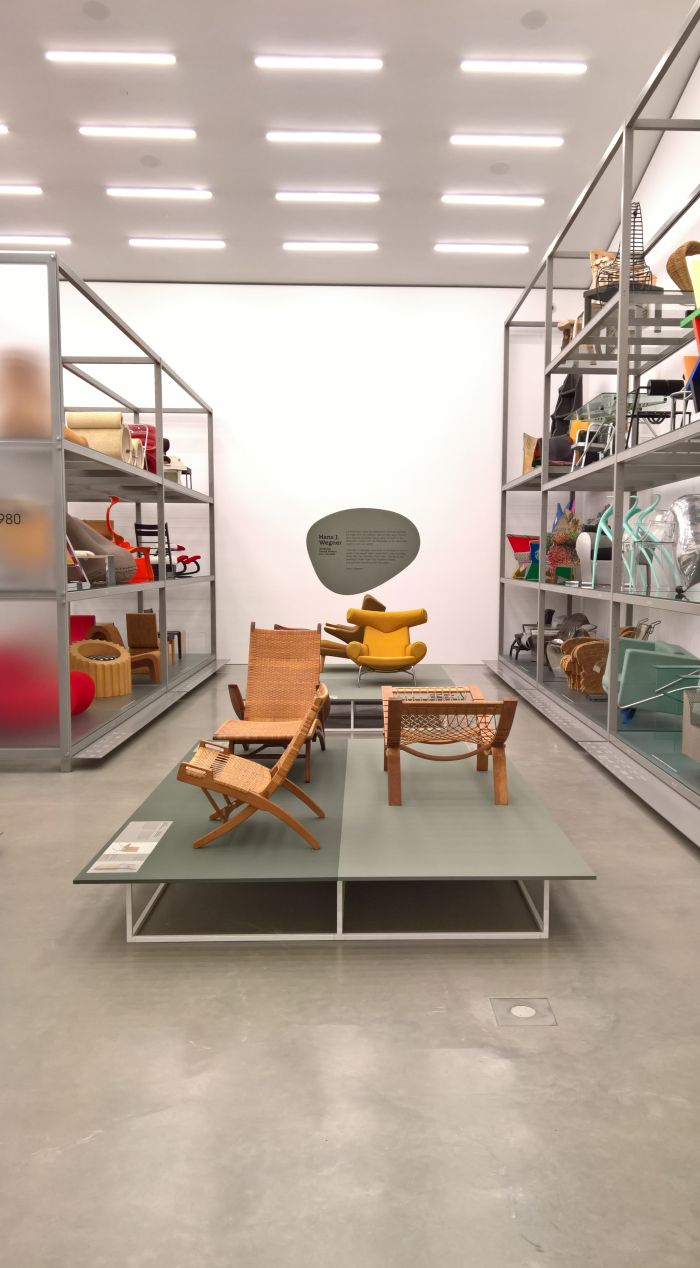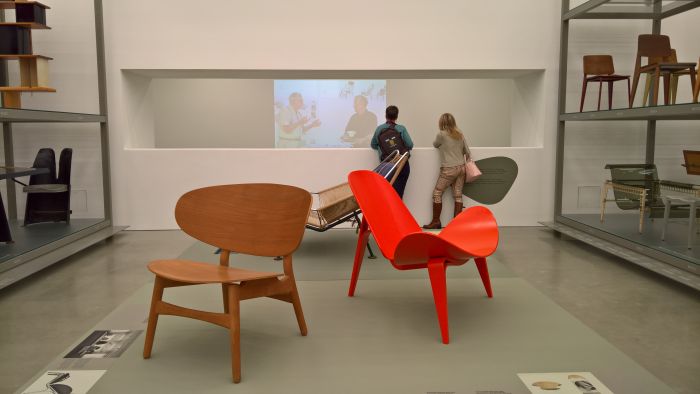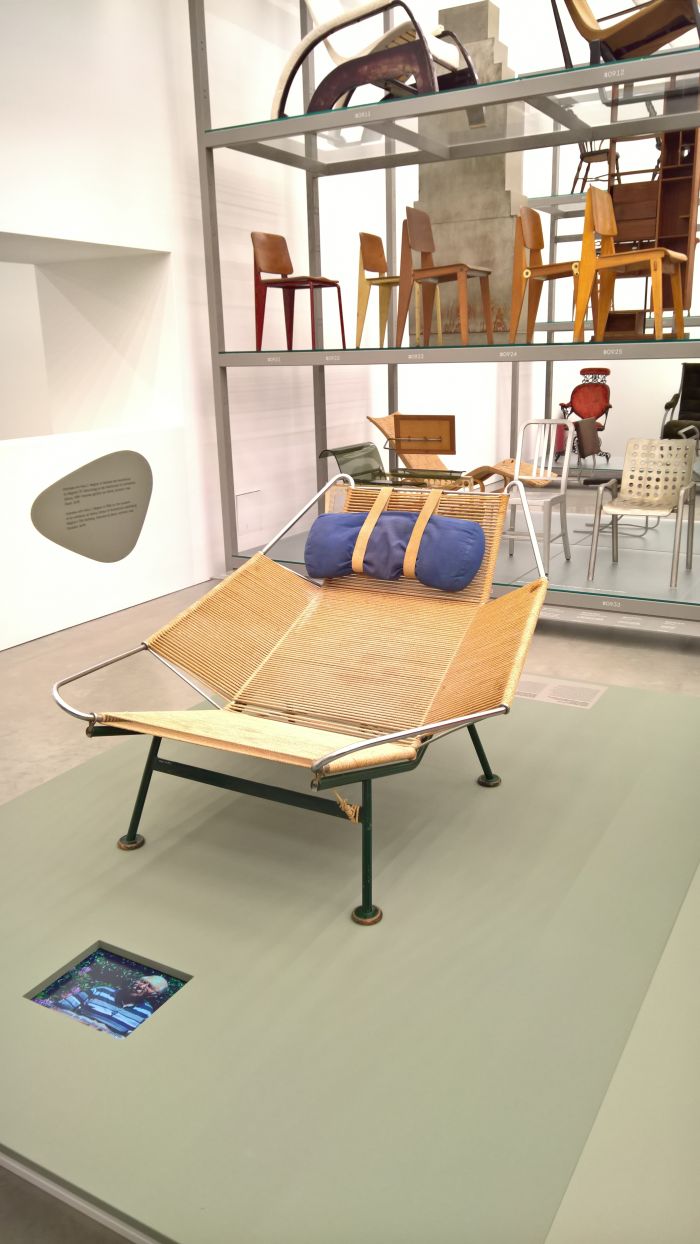Hans J. Wegner: Designing Danish Modern @ Vitra Design Museum Schaudepot
With the exhibition Hans J. Wegner: Designing Danish Modern the Vitra Design Museum Schaudepot explores the oeuvre of one of the Grand Doyens, and arguably one of the most widely misconstrued protagonists, of 20th century Danish design.
“If only you could design just one good chair in your life . . . But you simply cannot”1 opined Hans J. Wegner in 1952: and as if to prove his point designed over 500. And while not all good, the majority are arguably above average, and, equally arguably, Wegner produced more than his fair share of chairs which are interesting in terms of what they teach us about furniture design and the design process.
Yet being as he is a Danish designer who enjoyed particular, international, success in the 1950s and 60s his legacy is often shrouded by a popular focus on a few objects, some easy buzzwords and a lot of unnecessary, lazy, sales driven, PR nonsense.
The most important recent attempt to establish a more realistic impression of Hans J. Wegner is and was the 2014 book WEGNER – Just one good chair by Christian Holmsted Olesen, Head of Exhibits and Collections at Designmuseum Danmark.
And so it was very pleasing that Christian Holmsted Olesen was invited to give a talk on Wegner and his work ahead of the opening of Designing Danish Modern; not least because it helped underscore how the popular image of Hans J. Wegner obscures a much more interesting and complex reality.
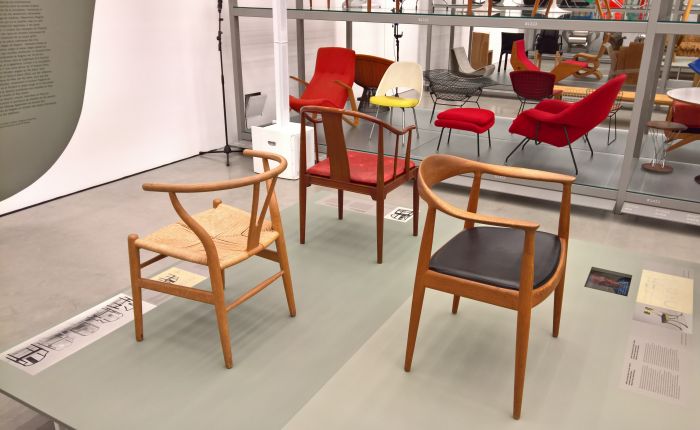
The CH 24 Wishbone or Y Chair (l.), the FH4282 China Chair (m.) & the JH501 Round Chair (r.), as seen at Hans J. Wegner: Designing Danish Modern, Vitra Design Museum Schaudepot
Born in the southern Danish town of Tønder in 1914 as the son of a master cobbler, we refer you dear reader to our Hans J. Wegner Design Calender post for the biographical background, here our concern is solely Wegner’s, not inconsiderable, oeuvre.
And oeuvre which after listening to Christian Holmsted Olesen one understands could have been not only more considerable, but more varied.
In our review of Just one good chair we noted, without reflecting further, that Hans J. Wegner’s career was regularly advanced by friends, contacts and associates: the Copenhagen Arts and Crafts School’s director Orla Mølgaard-Nielsen, for example, setting up the contact with not only Arne Jacobsen and Erik Møller, and thus enabling Wegner to take his first professional steps, but also connected Wegner with the cabinet maker Johannes Hansen who became one of Wegner’s most important producers and for whom he created many of his most celebrated designs; or there is the role of the Copenhagen furniture dealer Eivind Kold Christensen who arranged contact with producers such as Getama, A. P. Stolen and Carl Hansen & Søn, and thus allowed Wegner to become one of the dominant designers of his generation. Had we reflected further, which we really should have done, we would have realised the significance of the fact. Or perhaps better put, and as Christian Holmsted Olesen makes very clear, had Hans J. Wegner met other people, his career, and therefore the popular image of him, would have been very different. Arguably more realistic.
The year 1949 provides a very pertinent example. At that years Copenhagen Carpenter’s Guild exhibition Wegner presented a range of furniture, including a lounge chair featuring moulded plywood shells on a laminated wood base. We’ve only seen photos, photos which give the impression of a fairly ungainly object, arguably one not yet fully developed, but equally arguably an interesting and promising proposal which unquestionably moved furniture design in new directions; and which one learns in Just one good chair was much admired by the Danish press. Wegner however couldn’t find a manufacturer for the chair, did however for another chair he presented: the handcrafted, solid wood JH501, popularly known as The Chair, and the work that largely established Wegner’s international reputation, opened up new doors and avenues to him and which also played a key role in establishing the enduring idea of Danish craftsmanship in furniture design. Even if according to Christian Holmsted Olesen Wegner himself wasn’t overly impressed with the JH501.
But what if he’d found a manufacturer prepared to invest in his moulded plywood lounge chair?
It wasn’t as if it was his first moulded plywood chair, in 1948 Fritz Hansen had released the FH1936 moulded plywood chair and FH1935 moulded plywood sofa. He’d demonstrated his understanding of and competence in the material. What if in 1949 he’d found a manufacturer who had encouraged his research in that direction?
What if he’d met a Vitra? asked Christian Holmsted Olesen.
And our thoughts went transatlantic. In 1941 the first Knoll programme was the work of the Dane Jens Risom, subsequent catalogues featuring contributions from the Dane Abel Sorenson and the Finn Eero Saarinen. In 1947 George Nelson took over as Design Director at Herman Miller, brought in Charles & Ray Eames, largely on account of their moulded plywood work, and tried to sign up Alvar Aalto, largely on account of his laminated wood work. In 1948 Hans J. Wegner participated in the MoMA New York’s International Competition for Low-Cost Furniture Design, presenting a moulded plywood chair. The 1952 Herman Miller catalogue features moulded laminated and plywood works by the Danes Peter Hvidt & Orla Mølgaard-Nielsen, yes that Orla Mølgaard-Nielsen, works licensed from Fritz Hansen, yes that Fritz Hansen.
We yield ground to no-one, but no-one, in our admiration for George Nelson, but why wasn’t he on the phone to Hans J. Wegner?*
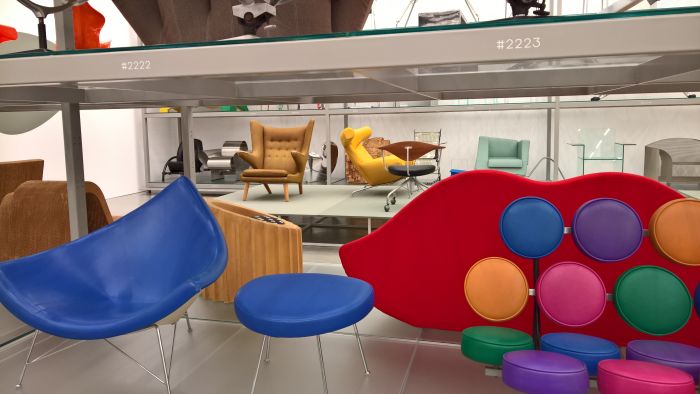
…in context of the exhibition there is a welcome dialogue between Hans J. Wegner and George Nelson….
Much as the story of Hans J. Wegner, and by extrapolation the story of post-War Danish design, could/would have been so different if someone had taken up his moulded/plywood works, it could/would have been even more so had anyone responded to his later wish to create a plastic chair. Yes. Hans J. Wegner. A plastic chair. Why not? And an argument that becomes all the more tantalising in context of one of the highlights of Christian Holmsted Olesen’s talk: a photo showing Hans J. Wegner, with wife and daughter, together with Verner Panton in the later’s apartment, a very, very, good time clearly being had by all. And according to Christian Holmsted Olesen, Hans J. Wegner had Verner Panton’s number saved as one of the ten pre-dials on his phone, indicating that even if they didn’t talk often, Wegner wanted to ensure that he could contact Panton quickly if need be.
It’s hard to imagine two more contrasting characters than the shy craftsmen Wegner and the gregarious Panton with his preposterous fascination with colour, but obviously there was an empathy, they had a connection. A connection one assumes was based on a mutual respect of the work each other produced. Or maybe as two ex-Arne Jacobsen employees they had a lot of shared experiences. Or perhaps it was the shared fate of failing to find a Danish producer adventurous enough to help them develop a plastic chair which bound them together. Blood brothers as it were, who both saw their creativity hampered by a Danish furniture industry that either couldn’t or wouldn’t move outside its own box. Even if, or perhaps because, it was a particularly finely handcrafted wooden box.
The one left Denmark where he found partners prepared to follow him and visions, the other remained, and became Denmark.
Consequently through Hans J. Wegner one understands that while, and as previously discussed with Thomas Dickson in context of the exhibition Much More Than One Good Chair. Design & Society in Denmark, the economic situation in Denmark in the pre-and immediate war years was of central importance for shaping design in Denmark, they simply couldn’t afford the materials and machines necessary to develop in alternative directions, so to were the relatively, when not conservative, then certainly unadventurous, narrow attitudes of the contemporary Danish manufacturers.
Which isn’t to denigrate what Hans J. Wegner achieved, far from it, is however to ask, what if…….?
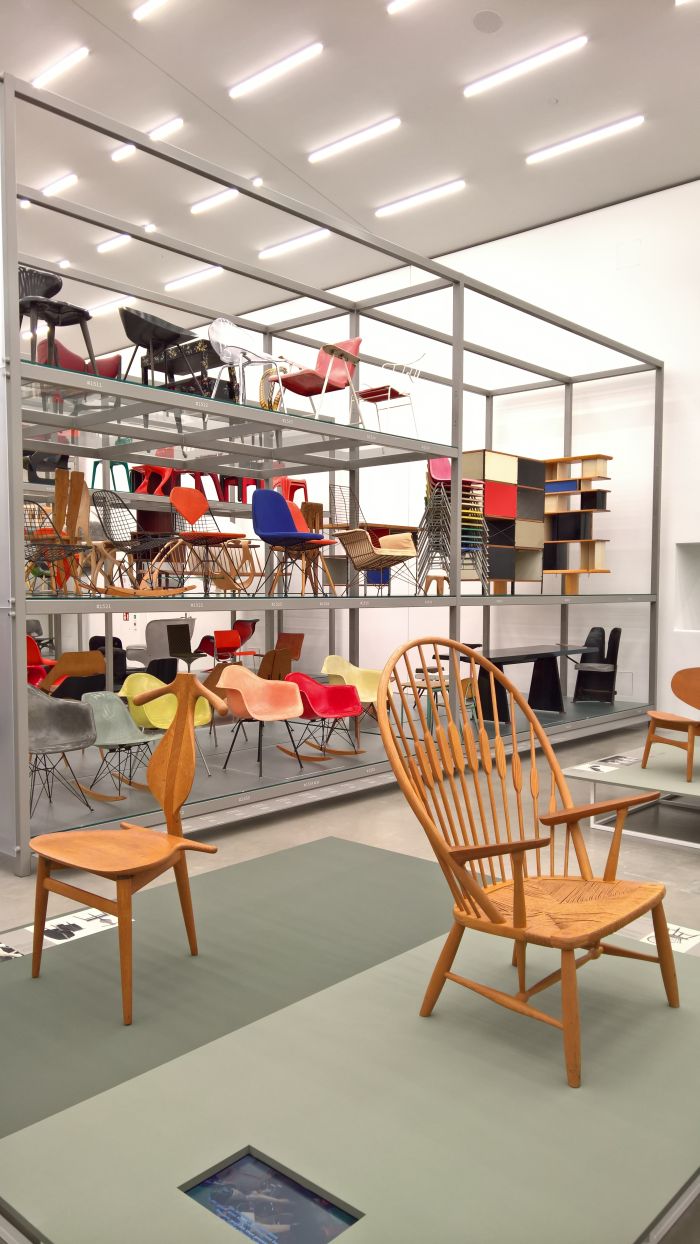
The JH540 Valet Chair (l.) & JH550 Peacock Chair (r.), as seen at Hans J. Wegner: Designing Danish Modern, Vitra Design Museum Schaudepot
Interesting and entertaining as such “what if?” considerations are, one should however also never forget that a large part of what Hans J. Wegner became was where he came from. A naturally skilled, and very passionate, cabinet maker, who learned about wood in his father’s workshop, Wegner studied furniture design at the the Kunsthåndværkerskolen, the Copenhagen Arts and Crafts School, under Kaare Klint and therefore was taught that furniture was crafted from wood, ideally noble woods such as Klint’s beloved mahogany, but for all that good, meaningful, correct furniture design is based on evolving established forms and models. And that is largely what Wegner did his whole career, evolved vernacular objects, the work of his contemporaries and his own designs ever further, ever further, ever further, ever…..
In our review of Just one good chair we noted that it established “a profile of a man who understood the traditions of Danish carpentry, understood the value of proven, established forms and who was one of the first practitioners to understand the importance of not only interpreting these proven, established forms in new, modern ways, but of also of re-interpreting the basic tenets of Danish carpentry. And who thus helped advance a new approach to furniture design and an aesthetic that perfectly complimented the uncompromising formality of the dominant modernist architecture of the period.” Viewing Designing Danish Modern strengthened the resolve with which we wrote those words. While also forcing us to question if they weren’t a little too restrictive.
Curated by Heng Zhi Designing Danish Modern presents some 16 chair designs by Hans J. Wegner, works which represent not only different stages in his long career, but also different facets of his work, different understandings of Hans J. Wegner, thereby bringing colour to the popular, and highly unfair, monotone image of Hans J. Wegner.
Alongside familiar Wegner works such as the JH501, the JH550 Peacock Chair or the upholstered Ox Chair, stand works such as, for example, the much more idiosyncratic metal and cord Flag Halyard Chair for Getama, a work which neatly demonstrates that Wegner ≢ handcrafted wood, and two loungers, the JH511 Long Dolphin Chair and the GE2 Hammock lounger: the former representing for us an excellent example of how Wegner could over develop, over evolve, his ideas, that through his focus on continually evolving his designs, he could, occasionally, lose sight of the essentials. The JH512 folding chair from 1949 is an exquisite and very intelligent piece of work, yet one which when developed further into first the JH510 Dolphin Chair and subsequently the JH511 Long Dolphin Chair, successively loses its grace, charm, logic, necessity and unassuming self-confidence. In contrast in the GE2 one finds a very pleasing further development of the base of the 1949 Lounge Chair no one wanted to produce. Less sure about the hammock inlay, but….
Then there is the singularly singular JH540 Valet Chair, a chair which on account of its subtle criticism of functionalism wouldn’t look out of place in W. Heath Robinson and K. R. G. Browne’s book “How to live in a flat”, and indeed in its functional irreverence can almost be considered postmodern. Danish Organic Postmodernism, anyone? Is however also just the most eloquent and absorbing piece of design.
The chairs are ably supported by sketches, videos and photographs which help explain the creative process that led to them, the inspirations, if you will, the logic, while a longer film of Wegner discussing his works provides that extra bit of depth and brings a genuine relevance and value to the showcase. Having a copy of Just one good chair to hand is also (always) advisable, there weren’t any there at the opening, but we’re sure the Vitra Design Museum can find a copy or two.
If, as we believe, Hans J. Wegner is one of the leading figures of 20th century Danish design, one of the reasons for the level of myth that is mixed with the truth in popular considerations on post-war furniture design in Denmark, then properly, correctly, understanding Hans J. Wegner is important to properly, correctly, understanding Danish design. Hans J. Wegner: Designing Danish Modern doesn’t do that on its own, by necessity of (lack of) space it simply cannot have the depth or scope; however, as a starting point for questioning your own understanding of both Hans J. Wegner and the relevance, context, validity and importance of his work, it is an excellent, accessible and highly entertaining showcase.
While its location amongst a century and more of chair design deliciously underscores that there really is no one good chair. But as Hans J. Wegner teaches us, that is no reason to stop trying to develop it…..
Hans J. Wegner: Designing Danish Modern runs at Vitra Design Museum Schaudepot, Charles-Eames-Straße 2, 79576 Weil am Rhein until Sunday June 3rd
Full details can be found at www.design-museum.de
1. Quoted in Christian Holmsted Olesen, WEGNER – Just one good chair, Hatje Cantz Verlag, Ostfildern, 2014
*There is obviously the question of what would have happened had Nelson contacted Wegner. Others did, without success. As Christian Holmsted Olesen notes in Just one good chair, in 1953 an American manufacturer approached Wegner to enquire about producing his chairs under license in the US. Wegner said no, insisting they were only to be made in Denmark by Danish craftsman.
Who that manufacturer was is currently lost in the mists of time; we like to think it was a Hermann Miller, a Knoll, a Dunbar or a Baker, who were having good experience at the time with the designs of Finn Juhl.
But 1953 is logically post 1949 and so post The Chair and Wegner’s renown as a maker of handcrafted chairs, which is what that manufacturer would have, presumably, been interested in, the discussion above concerns industrial moulded furniture, and so yeah, what if George Nelson had got in touch…..? The Danes weren’t interested, what if Hans J. Wegner had moved to Michigan in 1950?
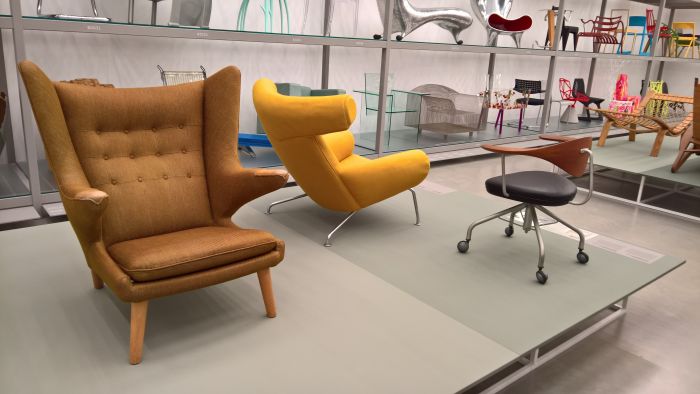
Papa Bear Chair (l.) Ox Chair (m.) & JH502 office chair (r.), as seen at Hans J. Wegner: Designing Danish Modern, Vitra Design Museum Schaudepot
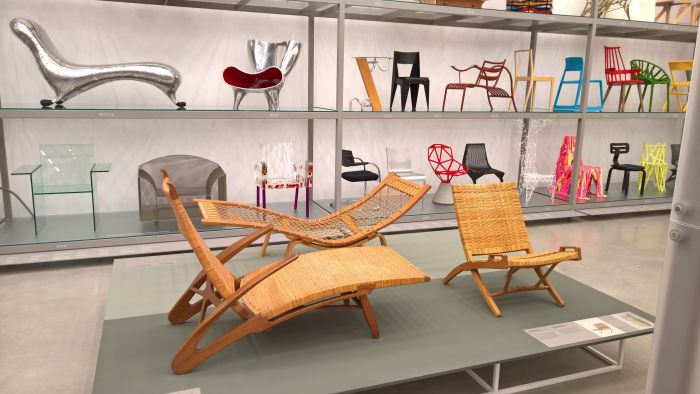
The JH512 folding chair (r.), JH511 Long Dolphin Chair (front) & GE2 Hammock lounger (rear), as seen at Hans J. Wegner: Designing Danish Modern, Vitra Design Museum Schaudepot
Tagged with: Hans J. Wegner, Schaudepot, Vitra Design Museum, Weil am Rhein
